In my time educating the public about Florida turtles I have found that most Floridians have not heard of diamondback terrapins. They have heard of, and seen turtles, but are not sure what the names of the different species are and are not familiar with the term terrapin at all. Which brings up the question – what is the different between a turtle, a tortoise, and a terrapin?
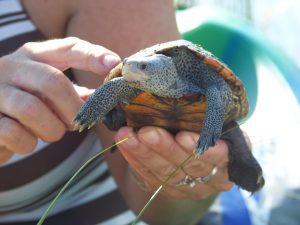
Photo: Molly O’Connor
Honestly, they are cultural terms and not “biological” descriptions. We associate the term “tortoise” with a land turtle – and this is true – yet we call the box turtle a “turtle” – which is fine. In Great Britain they call almost everything a “terrapin”. The term “terrapin” is a Delaware Indian term meaning “edible turtle”. Most turtles are edible, but this term stuck to a group of brackish water turtles in the Chesapeake area near Delaware we now call “terrapins”.
In the Mid-Atlantic states, terrapins are more known than they are here – and they appear to be more abundant. They are the mascot of the University of Maryland, and the official state reptile there. “Turtle Soup”, a popular cultural dish in the Chesapeake, is made with terrapins. It was served as part of the state dinner when Abraham Lincoln was president – considering it a classic “American” dish. They were harvested by walking through the marshes with a burlap sack and a gig. A sack could bring a harvester about $10, but when the popularity of the dish increased, hand harvesting could not keep up with demand and terrapin farms began. I know there were terrapin farms in the Carolinas, but there was one near Mobile, Alabama as well. Apparently, terrapins existed outside of the Chesapeake – and that brings us back to Florida… we have them too!
There are seven subspecies of this brackish water turtle. They range from Massachusetts to Texas. It is the only resident brackish water species, spending its whole life in salt marshes (or mangroves in south Florida). Florida has five of the seven subspecies, and three of the seven ONLY live in Florida – yet most of us do not know the animal exist.
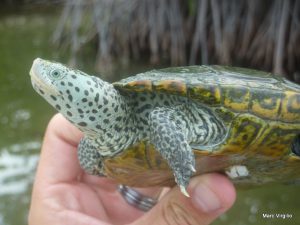
Photo: Marc Virgilio.
Very few researchers worked with terrapins in this state – there was virtually nothing known about them in panhandle. In 2005 I began to survey panhandle marshes to see if terrapins existed here. I grew up in the panhandle, and like so many others, had never seen or heard of one. I asked local fishermen who use to gillnet the marshes back in the 1950s and 1960s (when it was allowed) if they were aware of this this turtle. I asked them “did you ever capture a terrapin?” They did not know what I was talking about. And then I showed them a picture… “OH… yea, we did catch these once in a while – what are they called again? Terrapins?”. This was a game changer for me in terrapin education – show them a terrapin and ask if they have ever seen a turtle that looks like this.
The response was still “what is that? It’s beautiful!”… and they are. Terrapins have light colored skin with dark specks or bars – a really pretty cool looking turtle. Oh, and they are in the panhandle, just not in big numbers – or, at least, we have not found them in big numbers 😊.
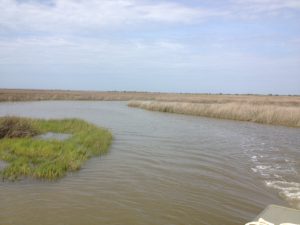
Photo: Rick O’Connor
These brackish water turtles spend their entire lives in a marsh system feeding on mollusk and crustaceans. Like map turtles (their nearest cousins), the females are larger with wide heads for crushing the shells of their prey. They are considered an important member of the ecosystem in that the reduction of terrapins can cause an increase in the marsh periwinkle (a popular snail food) who would in turn stop feeding on leaf litter and attack the live plants themselves – threatening the existence of the marsh. So, they are important predators on marsh grazers. Not having a lot of trees in a salt marsh, you do not see them basking on logs as you do with other riverine turtles. They do, however, exit the water and bury in the mud/sand for long periods to bask.
After mating, the females usually leave the marsh for the open estuary, swim along the shorelines looking for high/dry ground for nesting. More often than not, these are sandy beaches – but they have been known to dig nest in crushed shell mounds, dredge spoil islands, along highways, backyards, and even runways of airports – wherever “high and dry” can be found in a marsh. In Louisiana a lady found one roaming around inside her outdoor shower – good luck nesting there!
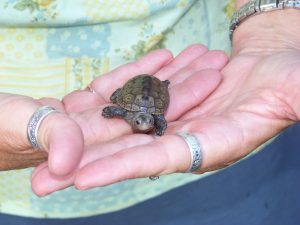
Photo: Molly O’Connor
The females lay about 10 eggs in a clutch and will lay more than one clutch each year. Baby terrapins are one of the coolest looking turtles you will see. They emerge from the nest in late summer and fall, hiding in the wrack debris along the shoreline. It is believed they actually have a more terrestrial life early on before entering the water and living out their lives in the marsh.
The popularity of turtle soup has waned since the Civil War, as have the wild harvest and aquaculture projects. However, the turtle is still under tremendous pressure from humans. We began using wired crab traps in the 1950s and terrapins have a habit of swimming into these, where they drown. The problem is not that large in Florida, but in the Chesapeake, they have found as many as 40 terrapins in one crab trap! Most of these are “ghost crab traps” – ones that “got away” from the owner but are still harvesting marine live – including crabs. One paper indicated that in the early part of the 21st century, in one year in the Chesapeake, over 900,000 blue crabs died in ghost crab traps – a commercial value of about $300,000. So, the ghost crab trap is a problem whether it kills terrapins, redfish, flounder, or blue crab. Today, many crab traps have biodegradable panels so that if the trap “gets away” it will eventually breakdown and not capture organisms like terrapins. In the Chesapeake many states require crab traps to have a By-Catch Reduction Device (BRD) to keep terrapins out – but allow crabs in. They are not required in Florida, however FWC will provide them for free if you are interested. I have some in my office in Pensacola and more than willing to give them to you. FWC also hosts crab trap removal programs, and I encourage you to participate in these.
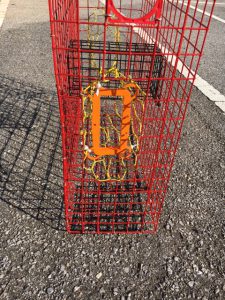
Photo: Rick O’Connor
A bigger issue for Florida is the land-based predators. As we moved closer and closer to the salt marshes, we built bridges and roads that allowed land-based predators to reach the nesting beaches they previously did not have access to. Raccoons in particular are a big problem, depredating as many as 90% of the terrapin nests. Poaching for the pet trade is rising and FWC is working on this. Several major arrests have been made in Florida in recent years. It is illegal to sell Florida turtles, so do not buy them if you see them being sold somewhere. Report the activity to FWC.
Due to all of this, terrapins afford some form of protection in each of the coastal states where they exist. Some list them as “endangered” or “threatened”. In Florida, they do not have this label, but they are protected by FWC. No one is allowed to have more than two in their possession, and you are not allowed to have any eggs.
It is an amazing turtle. I currently conduct a citizen science program monitoring them in the western panhandle. I have a lot of eager volunteers wanting to see their first one in the wild. I hope they do soon. I hope they hang around long enough for everyone to see one in the wild.
 0
0
